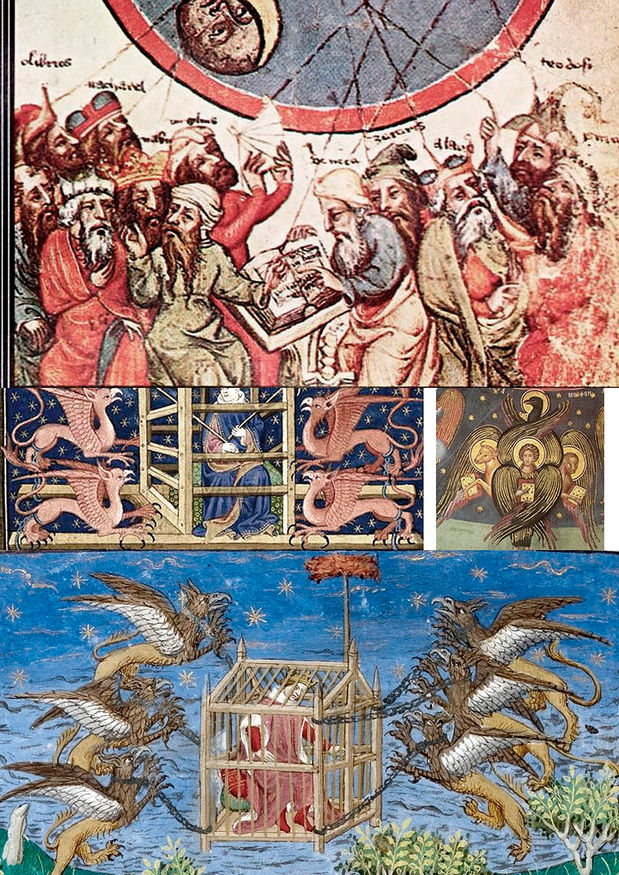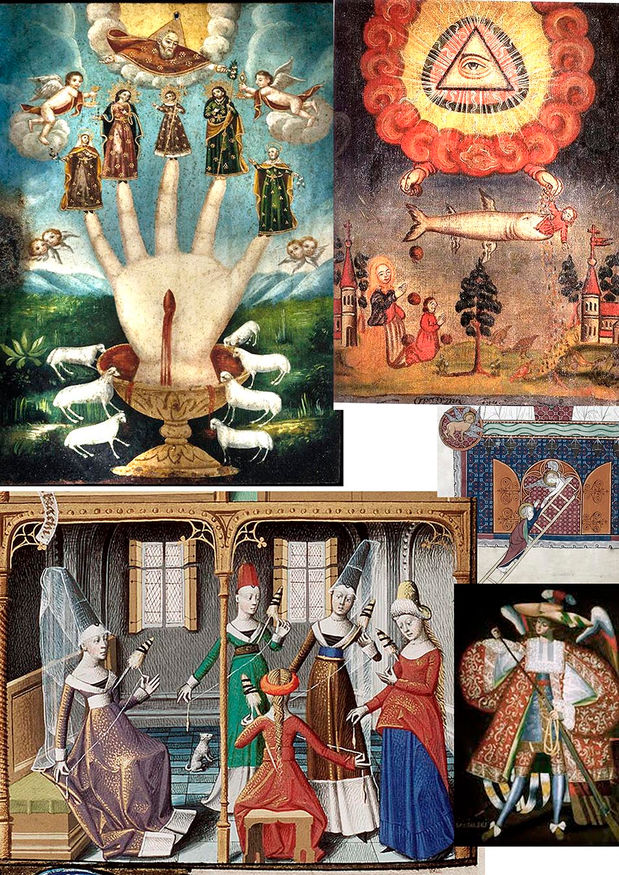artistic illustration projects
About Loreta and the Mirror
16/03/2025
It has taken me more than six years to finally bring this story to a close. This has happened to me before with other projects, where the absence of deadlines and the periodic review of my work lead me into an endless cycle of revisions, always uncovering aspects that can be improved. I don’t rule out making further adjustments, but I doubt they will be significant.
I must thank Lorenzo Pascual, Juan Bullón, and Vanessa Giménez Garrido for their support in offering their perspectives and analyses. It is so easy to get lost in the complex craft of writing, especially for those of us who were not born naturally gifted in it.
A fable about self-knowledge


Loreta and the Mirror is a fable about the journey toward self-discovery and the psychological nature of individuals. The characters embark on an adventure in search of answers to terrifying visions revealed through the reflections of a mysterious mirror.
As a metaphor, the work speaks to us about the importance of embarking on a difficult and long journey to know oneself, in order to avoid being dominated by the most unhealthy and destructive aspects of one's character.
The work is narrated like a children's story, but it is not a project for children, although it can be read at certain ages. It unfolds with an experimental visual and narrative language, featuring images and a blend of narration and poetry with a cryptic appearance, where all the elements have a symbolic meaning. It is also specially developed for reading on mobile phones.
Symbolism of the characters

The mirror with which this adventure begins symbolizes the tool or the individual's will towards self-knowledge through psychological analysis, which allows us to shed light on and understand our character, thus better confronting our neurosis. This is understood as that inherent character trait in all people, which is so well depicted by psychiatrist Claudio Naranjo in his work Character and Neurosis: An Integrative View.
It is a black mirror because it reflects not the apparent, but the hidden.

Loreta is a girl who constantly seeks perfection in life but is unaware of what happens within her. She seems like an extremely balanced person who has managed to control "her moments of fury."
But her nickname precedes her: "the one with the bad temper," and it is through the mirror that she will discover hidden aspects of herself that she never imagined: inside her, there is a hidden lizard, that part of her behavior that acts unconsciously, and the mirror reveals it to her, like the bad temper and anger she can only contain with great discipline but without true understanding of the cause (the chained dragons near her house).

She will also discover in the mirror the immense Infernal Monster that devours the world, a symbol of that hidden, self-destructive part of Loreta and of all humanity; perhaps a projection of what we could become if we let loose our most neurotic side.
After a journey of self-discovery, this monster will not disappear, but it will become no more than an annoying mosquito, a part of herself recognized and accepted with serenity: this is the reward after the journey for answers. It's not that she ends up reshaping her identity; she integrates it, with all its good and bad, and accepts it without any anger, with an honest gaze (the painting with which she self-portrays at the end of the story, next to the mosquito).
A similar meaning is found in her chained dragons, which will disappear once she recognizes herself for who she truly is, thus ending her internal struggle and contained anger.



The bearded ones are the scholars, those who study and build theories and sciences.
They represent the scientific spirit that offers Loreta a formal path (therapeutic process) to access self-knowledge, and it is they who invite her to contemplate, in the reflection of the mirror, the lizard and the Infernal Beast.
By suggesting she search for an explanation for these images, the bearded ones are encouraging her to begin her journey of self-knowledge. However, I must admit that in a work where everything has a symbolic meaning, their constant presence lifts Loreta's skirts, and without her realizing it, there is no logical explanation other than that they are shameless, disrespectful, and whatever my psychoanalyst may find.
Magpie, Perrucho, and the geese. Magpie and Perrucho appear as simple travel companions, funny characters who, when the time comes, will disappear, revealing the true value of the geese. The geese enter the scene just after Magpie and Perrucho's disappearance and symbolize attachments, that is, those primordial and secure emotional bonds that, for unknown reasons, Loreta turned her back on or forgot.

They are the ones who will return to support her in her darkest hours (when she enters the interior of the Infernal Beast, the hardest part of self-knowledge), while those fleeting friendships, Perrucho and Magpie, will abandon her in this case.

The maps, a symbol of knowledge, a guiding tool inherent to the bearded scholars. They will be prominently featured throughout the pages of the story.


The Canines are the ones who give the mirror to the bearded scholars: what better symbol than death to highlight the value of life, its finiteness, and the importance of knowing which person truly resides within each of us. They act as the master of ceremonies in this story, opening and closing it.

The Celestial Gods never interact with Loreta, seeming to ignore her. They are silent Gods because the world of the gods, even though they play with our lives, is foreign to ours and will never address us directly.
They insert their hands into a labyrinthine tower (the symbolic place where humans live) and through tubes—telescopes, microscopes, the Eye of God?—they manipulate and control the golden threads that move the animal within each individual, which in turn dominates them.

In any case, they symbolize the answers that religions can provide us. In my case, as an atheist, I cannot knock on the door of faith, which is why I feel the need to keep searching for answers elsewhere, regardless of the fact that Loreta's questions have nothing to do with the world of faith.


The canines merely accompany us, reminding us of our finitude, but the animal on our backs (or inside us) can eventually overpower us, even strip us of our human skin if we do not act with full awareness of who we are: an image that each one has of themselves in front of a reality often unrecognized (the lizard in Loreta’s case) that we don’t even identify as part of ourselves. That awareness is the path that prevents us from submission, and it is the path Loreta must travel.

Astro Rey is the Sun that appears during Loreta’s fall through the Cosmos, a symbol of life. He encourages her to look within "the very Infernal Beast": that is, within her own emotional and psychological depths, in the visceral and emotional core of her being. He is also the one who facilitates Loreta’s reunion with her geese, her childhood family.

And it is precisely there, in the entrails of the Infernal Beast, where Loreta will connect with her family constellations: the golden threads that we already saw the Gods manipulating. These threads are the common link of civilization, the pathways through which culture is transmitted from generation to generation, and something much deeper: human bonds, attachments, affections, and the development of emotions.


The spinners represent that constant effort to rebuild the damage caused by traumas, even inherited across generations. It is the work of civilization from a humanistic perspective, as they weave human skin, the cultural shell that can contain the animal that resides in all of us. They are women, obviously, as they are mothers, and they weave with golden threads, as we see on the ground, the primary raw material with which to weave.

The awakening of self-awareness brings the sensation of having lived in a "deep sleep" of unconsciousness, a previous incomplete life that somehow now restarts with renewed vitality in a new way of living. This is why, at the end of the story, all the characters return to childhood, including the Infernal Monster, transformed into a friendly, playful dragon.
In reality, everything is the consequence of the spell cast by the spinners when they open the doors of consciousness with their explanations, which are scarce but enough.
It is a path, however, that never truly ends. Loreta, now elderly, will only return the mirror to the Caninas upon her death, as self-knowledge is not an exercise to be completed. On her deathbed, Loreta abandons the old woman she was, the lizard she always was but did not always accept, and what remains or endures is her soul, symbolized as a child, connected to the golden thread, that which ties her to humanity, to the past, and to the future, heritage, and legacy.
Graphic references and style
Finally, regarding the aesthetics of the work, I have illustrated almost all the elements based on pictorial references, primarily medieval, not only because of my appreciation for the aesthetics and imagery of that period, but also due to the importance of historical legacy and cultural heritage as part of the theme explored in this story. However, unlike my previous story (Soy pez soy pájaro soy lombriz, Diábolo Ediciones - Diabolín collection), I have not made a faithful recreation of that aesthetic, but rather a free interpretation, mainly seeking simplicity in the colors to frame different parts of the work and signify certain elements.








